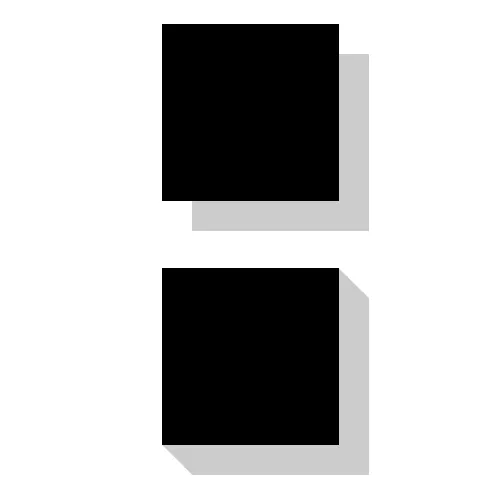我知道如何使用CSS3实现基本的盒子阴影,您可以在下面的图形顶部看到。
我想要实现的效果是一个三维盒子阴影,如下图底部所示。
有没有关于如何使用CSS3盒子阴影实现这个效果的想法?

我知道如何使用CSS3实现基本的盒子阴影,您可以在下面的图形顶部看到。
我想要实现的效果是一个三维盒子阴影,如下图底部所示。
有没有关于如何使用CSS3盒子阴影实现这个效果的想法?

不幸的是,盒子阴影实际上只是平面层。但是您可以应用多个盒子阴影来创建此效果。
.box-shadow-3d{
box-shadow: 1px 1px 0px #999,
2px 2px 0px #999,
3px 3px 0px #999,
4px 4px 0px #999,
5px 5px 0px #999,
6px 6px 0px #999;
}
你可以使用伪元素作为阴影
div {
background: black;
height: 100px;
width: 100px;
position: relative;
}
div:after,
div:before {
content: '';
background: grey;
position: absolute;
}
div:after {
width: 100%;
height: 20px;
left: 10px;
bottom: 0;
transform: translatey(100%) skewx(45deg);
}
div:before {
width: 20px;
height: 100%;
right: 0;
transform: translatex(100%) skewy(45deg);
top: 10px;
}<div></div>这里是用 perspective 和伪元素:before实现的真正的3D阴影。
body {
background: lightblue;
}
.foo {
position: relative;
display: inline-block;
-webkit-perspective: 1000px;
-moz-perspective: 1000px;
persepctive: 1000px;
margin: 20px;
margin-top: 50px;
}
.foo .box {
transform: rotateY(-40deg);
height: 350px;
width: 250px;
background-color: black;
}
.foo:before {
content: "";
top: -15px;
position: absolute;
width: 50px;
height: 375px;
background-color: grey;
transform: translateX(215px) translateY(2.7px) rotateY(55deg)
}<div class="foo">
<div class="box"></div>
</div>div {
background: black;
height: 100px;
width: 100px;
box-shadow: 0 01px gray,
01px 0 gray,
01px 02px gray,
02px 01px gray,
02px 03px gray,
03px 02px gray,
03px 04px gray,
04px 03px gray,
04px 05px gray,
05px 04px gray,
05px 06px gray,
06px 05px gray;
}
lightgray应用于右侧和darkgray应用于下方。 - Aaron Gillion以下是一段小型的实现,受到 @Vitorino Fernandes 的启发,使用 Stylus 实现...
offset = 10
border = 3
.offsetbox
margin offset
padding offset
text-align center
box-shadow inset 0 0 0 unit(border,px) black
background white
display inline-block
position relative
&:after,
&:before
content ''
background black
position absolute
&:after
width 100%
height offset
transform translatey(100%) skewx(-45deg)
right (offset/2)
bottom 0
&:before
height 100%
width offset
transform: translatex(-100%) skewy(-45deg)
left 0
top (offset/2)
div {
background: #bbb;
padding: 1em 1.2em;
width: 50%;
margin: 0 auto;
color: #111;
font: 150%/1.2 Georgia, Palatino, Times, serif;
position: relative;
}
div:after {
content:" ";
position:absolute;
top:0;
left: 0;
width:100%;
height:100%;
padding: 1.42em; /* (square root of gradient position) */
background: #000; /* Fallback if not supported */
background: linear-gradient(-135deg, transparent 2em, #000 0) top right,
linear-gradient(#000, #000) padding-box bottom right,
linear-gradient(45deg, transparent 2em, #000 0) bottom left;
/*I have avoided adding -webkit-, -moz and -0 prefixs for linear-gradient. You may put them in later to be extra safe*/
background-size: 50% 50%; /* There is no reason to paint the upper left quadrant, so I didn't. */
background-repeat: no-repeat;
-webkit-box-sizing: content-box; -moz-box-sizing: content-box; box-sizing: content-box;
/* Many people use border-box as default these days. Unfortunately, the box cannot be sized using border-box settings with the combination of padding in ems and percentages. So this is reset to content-box, just in case. */
z-index: -1; /* To keep the shadow behind the div*/<div>This is a short sentence to demonstrate that our little div is responsive.</div>:root {
--shadow-dimension: 20px;
--blue: #0039a6;
}
.box-container {
position: relative;
}
.box-container>div {
border: 2px solid var(--blue);
}
.box-container>div:after, .box-container>div:before {
content: '';
background-color: var(--blue);
position: absolute;
}
.box-container>div:before {
width: calc(var(--shadow-dimension) + 1px);
height: calc(100% + 100px + 1px);
left: calc(var(--shadow-dimension) * -1);
transform: skewy(-45deg);
top: calc(0.5*var(--shadow-dimension));
clip-path: polygon(0% 0%, 100% 0%, 100% calc(100% - 100px - 2px + var(--shadow-dimension)), 0% calc(100% - 100px - 2px));
}
.box-container>div:after {
width: calc(100% + 100px);
height: calc(var(--shadow-dimension) + 1px);
left: calc(-0.5*var(--shadow-dimension) - 100px);
bottom: 1px;
transform: translateY(100%) skewx(-45deg);
clip-path: polygon(100px 0%, 100% 0%, 100% 100%, calc(100px + 2px) 100%);
}